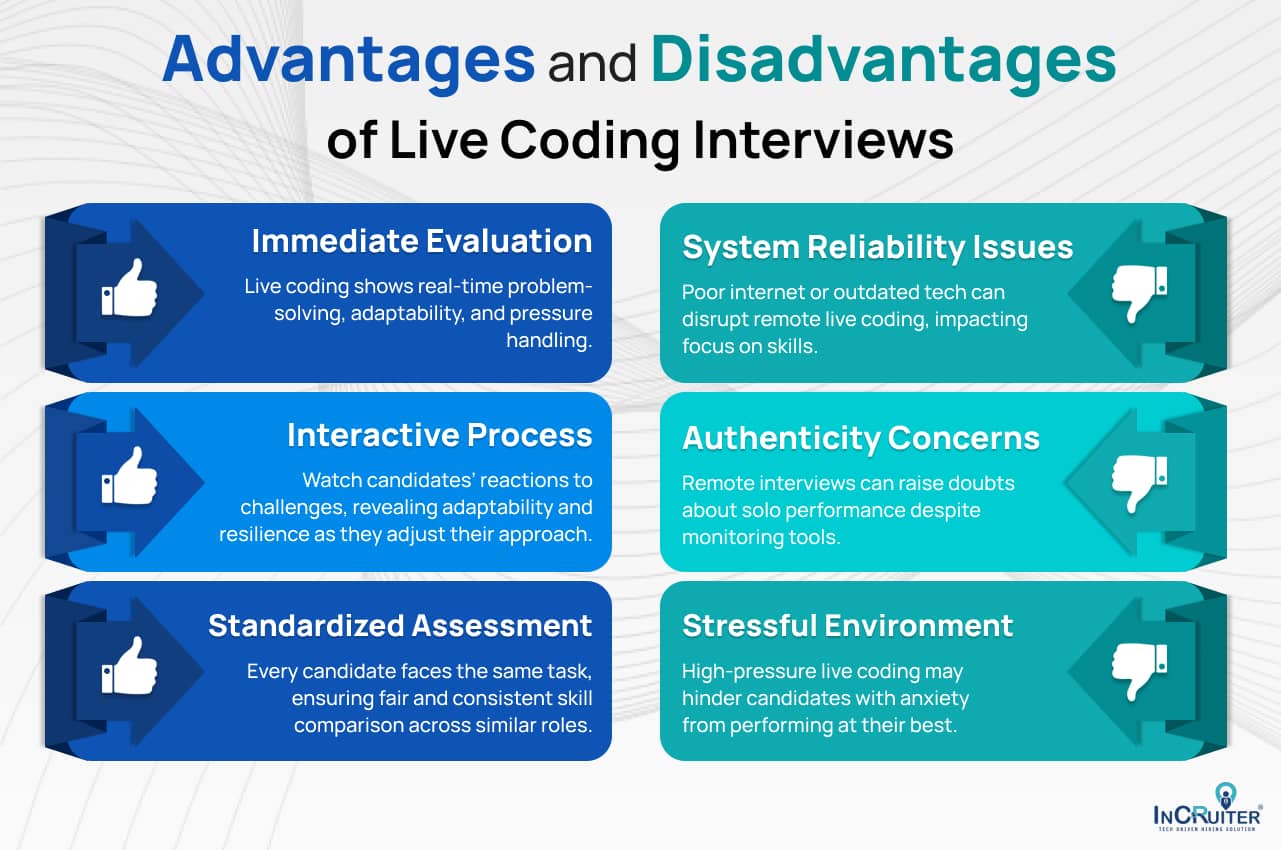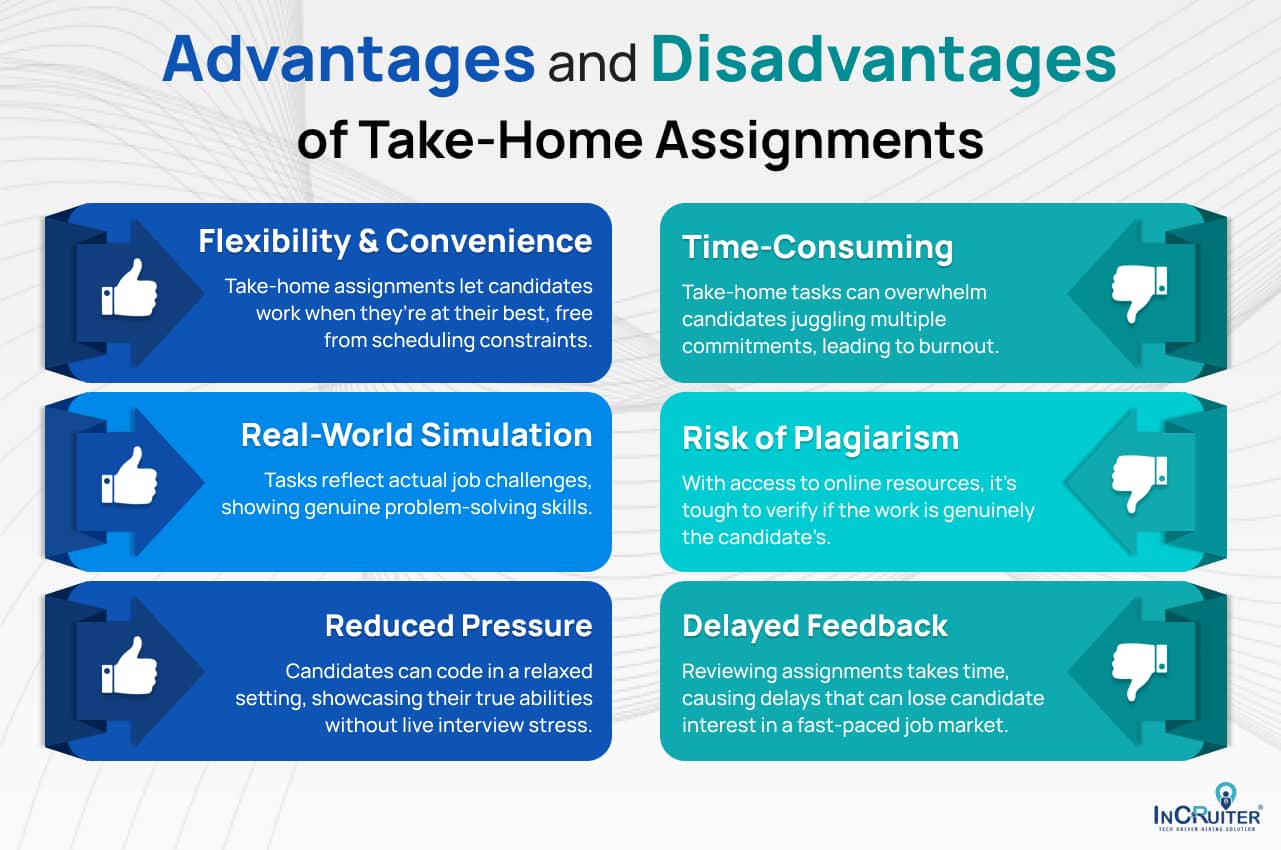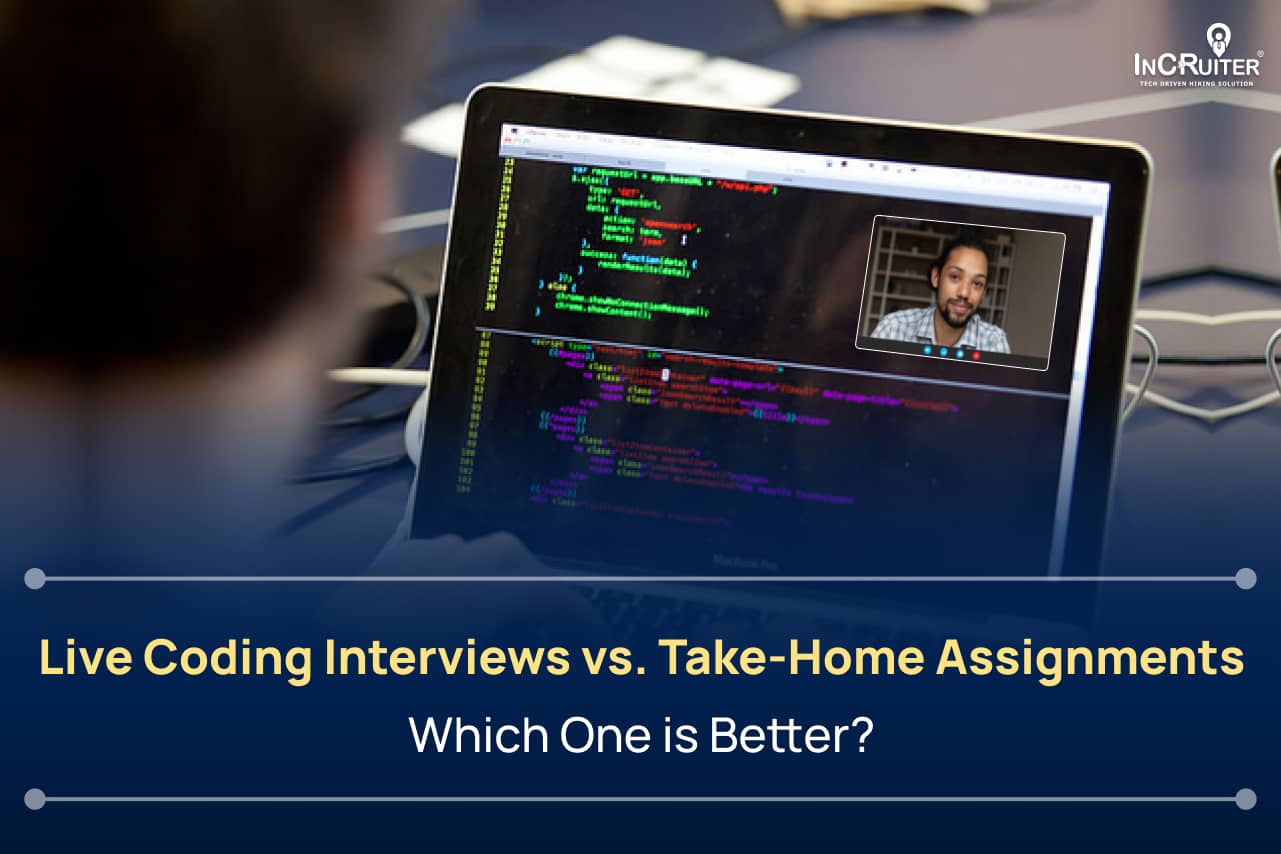It’s no secret that finding the perfect candidate isn’t just about technical chops; it’s about picking the right interview style to showcase those skills. In one corner, we’ve got live coding interviews the ultimate way to see if a developer can think on their feet. And in the other corner, there’s the take-home assignment, the calm and controlled option that lets a candidate work on their own terms.
Each of these approaches has its strengths, and let’s be honest, some pretty clear weaknesses too. So, if you’re caught in the classic dilemma of which interview style to go with, this guide is for you. We’ll dive deep into when each style works best, and hey, maybe there’s even a way to combine them!
What Are Live Coding Interviews?
Suppose you’re sitting across from a candidate, handing them a complex coding problem, and watching them debug, refactor, and iterate their way through it in real time. That’s a live coding interview in a nutshell.
The candidate tackles algorithms, navigates data structures, and optimizes logic, all while the interviewer observes (and occasionally nudges them toward cleaner solutions or better efficiency).
It’s the tech equivalent of asking a chef to whip up a gourmet dish from scratch. It’s all about seeing what they can design, refactor, and execute in the moment. Ideal for roles that need top-notch collaboration and sharp, adaptive problem-solving!
What Are Take-Home Assignments?
Now, let’s talk about the take-home assignment. Here, candidates are given a coding challenge to tackle on their own time, free from any watchful eyes. They get to focus on the problem, try out different approaches, and submit a refined solution.
It’s like giving an artist a blank canvas to work on over several days rather than asking them to sketch in five minutes. It’s less about speed and more about allowing them to develop something detailed, showing you the depth of their thought process and creativity.
Live Coding Interviews

Advantages of Live Coding Interviews
- Immediate Evaluation
In a live coding interview, you’re right there, observing a candidate’s skills in real-time. It offers a unique advantage: you get an unfiltered look at how they approach and solve problems, from the logic they build to the adjustments they make if they encounter obstacles. There’s no waiting on submissions or hoping they followed the right process.
Instead, you’re directly assessing their problem-solving style, coding knowledge, and ability to adapt under pressure. It’s a window into how they think on their feet, communicate ideas, and react in challenging scenarios, all of which are valuable insights for understanding their potential on the job.
- Interactive Process
A live coding interview gives you a unique window into a candidate’s brain. Revealing how they tackle problems on the fly. You get to see if they have a structured game plan or if they adapt as they go. Adjusting their approach with each new twist. It’s fascinating to watch how they handle the unexpected, a sudden bug, a tricky requirement, or a gap in their knowledge.
Every reaction, pause, and tweak in their code tells a story about how they process information and manage challenges. Do they stay calm under pressure? Are they willing to rethink their approach when something doesn’t quite work? This process doesn’t just show you what they know. But how they think and adapt, traits that are key for navigating complex, real-life projects.
- Standardized Assessment
Live coding offers a level playing field, where every candidate faces the same problem under the same conditions. This structure doesn’t just test coding skills. It brings everyone into the same experience, letting you see how each individual handles the challenge without any variations in complexity or format.
This uniform setup means that when you compare candidates, you’re truly comparing apples to apples. No extra ingredients, no special advantages. With live coding, there’s no second-guessing whether one candidate got an easier task or less time to work on it.
Every participant is responding to the same problem under the same timing. So, you’re left with a clear picture of each person’s ability to work through the same core challenges. This consistency streamlines your evaluation, giving you a fair, structured way to measure skills across the board. Especially useful when interviewing a batch of candidates for similar roles.
Also read: Top 10 Video Interview Software for Recruiters
Disadvantages of Live Coding Interviews
- System and Internet Reliability Issues
With remote live coding, tech issues can throw a wrench in the mix. Candidates rely on their own setup, so a glitchy internet connection or an outdated laptop can mess with their flow. Suddenly, it’s less about their skills and more about battling lag or disconnection.
And if they’re using a new coding platform, there’s that awkward learning curve mid-interview. It’s tough; these aren’t the kinds of things that should impact their chances, but they sometimes do.
- Authenticity Concerns in Remote Coding
Remote interviews can also bring a bit of a trust dilemma. When you’re not in the same room, it’s hard to be sure who’s really doing the work. Maybe they’re working solo, or maybe they’ve got an unseen buddy giving pointers.
For roles that need independent problem-solving, this can be tricky. Monitoring tools help, but they’re not foolproof, which means there’s always a bit of guesswork in evaluating a candidate’s true skills.
- Stress-Inducing Environment
Live coding can be stressful, especially for candidates dealing with anxiety, autism, or mood disorders. The high-stakes, on-the-spot format can heighten stress, making it tough for some to showcase their true abilities. Psychologically, the brain often goes into “fight or flight” mode under intense scrutiny, which can cloud clear thinking and problem-solving.
It’s not just about coding; it’s about managing a setting that doesn’t always support every candidate’s mental well-being, potentially sidelining qualified people who simply need a different kind of environment to excel.
Also read: Video Interview Tips: Complete Guide to a Successful Interview
Take-Home Assignments

Advantages of Take-Home Assignments
- Flexibility and Convenience
Instead of a rigid interview schedule, candidates get to pick their perfect coding moment. Whether they’re fueled by a fresh morning coffee or find their rhythm at midnight, take-home assignments give them that freedom. No need to squeeze in a quick coding session between back-to-back meetings or worry about WiFi glitches during a live interview.
It’s a real-time win-win. They can tackle the challenge when they’re genuinely ready, not when the clock says so. This approach not only respects their workflow but also lets them bring their A-game: no rush, no stress, just pure, focused coding. And for the hiring team? It’s a way to see candidates shine on their terms, not under the usual interview pressures.
- Real-World Simulation
Take-home assignments offer a hands-on way to evaluate candidates, mirroring the work they’d actually do if hired. It’s not just about whether they can write code; it’s about seeing how they tackle real problems, navigate unfamiliar challenges, and work independently to solve them.
With take-home tasks, hiring teams can observe a candidate’s problem-solving in action, getting a clear sense of how they think through solutions and apply their skills. It’s like a backstage pass to their coding style, from how they break down tasks to the techniques they rely on when things get tricky.
- Reduced Pressure
Coding live with an interviewer watching can feel like stepping into the spotlight, and not everyone’s a fan of the stage. With take-home assignments, that pressure is gone. Candidates get to code in their own space, whether that’s at a desk with coffee in hand or on the couch in their favorite hoodie.
This kind of relaxed setting lets them take their time, think things through, and come up with a solution that shows what they’re really capable of. There’s no need to rush or worry about saying the “right” thing in the moment. Instead, they can experiment, get creative, and submit a polished piece of work that reflects their true skills without those live-interview nerves tripping them up.
Disadvantages of Take-Home Assignments
- Time-Consuming for Candidates
Take-home assignments can really eat up a candidate’s time. If they’re already balancing other projects or job interviews, squeezing in a big coding task can feel overwhelming.
These assignments need full focus, and if they’re distracted or tired, it’s easy to lose track or get stuck. This kind of time commitment can be a dealbreaker for candidates who are actively job hunting, especially if they’ve got a lot going on.
- Risk of Plagiarism
Take-home assignments can make it tough to know if you’re getting a candidate’s authentic skills. With countless resources out there like coding forums, Q&A sites, and even AI tools like ChatGPT it’s easy for candidates to get a little “boost” with their work.
This doesn’t always mean they’re trying to cheat, but it does blur the line on whether the work is totally theirs. With so many tools within reach, hiring teams might struggle to get a clear, unfiltered look at the candidate’s true abilities.
- Prolonged Hiring Process
Take-home assignments, while flexible, can sometimes drag out the hiring process. Since these tasks are completed independently, it can take longer for hiring teams to review them and get feedback back to candidates. In fact, a survey by Robert Half showed that 1/4 of job seekers lose interest if the hiring process takes too long, understandable, right?
When responses are slow, candidates may start exploring other options or even accept other offers. While take-home tasks offer a thorough assessment, the delayed back-and-forth can make the process feel a bit sluggish in a fast-moving job market.
Also read: Video Interview Software: Enhancing Hiring Accessibility
When to Use Live Coding Interviews

- For Roles Needing Strong Real-Time Collaboration
Live coding interviews are perfect when teamwork is baked into the job. Think of agile environments where pair programming, brainstorming, and on-the-spot problem-solving happen all day long.
Live coding shows you how a candidate handles coding challenges with others, whether they can adjust their approach on the fly, and if they’re comfortable with back-and-forth collaboration, basically, if they’re ready to jump in and code as part of the team.
- To Assess Quick Problem-Solving Skills
If you’re hiring for a role that needs someone to think fast and stay cool under pressure, live coding is a solid choice. It’s all about seeing how a candidate handles those unexpected twists and turns right in the moment.
When they’re coding live, you get an up-close look at how they work through problems on the fly, whether they stay calm, spot the issue, and adjust without breaking a sweat. It’s a great way to see their adaptability in action and get a feel for how they’d tackle real-world challenges when the clock’s ticking.
- To Gauge Communication in Technical Discussions
For remote roles or ones with a lot of client interaction, communication is just as crucial as coding. Live coding test lets you see if a candidate can walk you through their thought process, ask smart questions, and handle feedback smoothly. You’ll find out if they can explain what they’re doing in a clear, straightforward way, essential for teamwork and working with non-tech folks.
A LinkedIn survey even found that 92% of hiring managers say strong communication skills are just as important as technical ones. So, live coding isn’t just about solving problems; it’s also about seeing if they can chat about it with ease!
When to Use Take-Home Assignments
- For In-Depth Technical Evaluation
Take-home assignments are ideal when you want to dive deep and see a candidate’s full technical range. For roles that require complex problem-solving or specialized skills, a take-home task lets them really show off.
They have the time to get into the nitty-gritty, try out different approaches, and deliver a polished solution without the rush of a live session. This format helps you get a genuine look at their expertise and see if they’ve got the technical chops for the role.
- When Flexibility Is Essential for Candidates
Life is busy, and sometimes candidates need a bit of flexibility. Take-home assignments let them fit the task around their own schedule, whether that’s early morning, late night, or a weekend grind.
This kind of setup can make the experience way less stressful, especially for people who are balancing jobs, family, or other interviews. It’s a way to meet candidates halfway and gives you a chance to see their skills without piling on the pressure.
- For Reducing Bias in Initial Screening
Take-home assignments can be a big plus for reducing bias, as you’re evaluating what they’ve actually created without the influence of personality quirks or nerves in the moment. It’s all about the work, and that makes it a solid, unbiased first filter in the hiring process.
Hybrid Approach: Combining Live Coding with Take-Home Assignments
The hybrid approach gives you the best of both worlds. Here’s how it goes: first, candidates tackle a take-home assignment at their own pace, letting them dive deep. Get creative without a ticking clock.
Once they’re done, you bring them in for a live coding session. Let interviewers to confirm that the assignment is truly their work. This mix is all about balancing one part thoughtful coding. One part is live problem-solving, giving you a real feel for both their skills and authenticity.
Benefits of a Hybrid Model
- Balanced Skill Assessment
This combo covers it all. With the take-home part, you get to see how they tackle a complex problem on their own. Then, the live session lets you see if they’re comfortable making changes on the fly. Can they adapt, troubleshoot, or improve their code when asked?
- Enhanced Candidate Experience
A hybrid approach feels less like a spotlight and more like a conversation. Candidates get to work in their comfort zone first. Then, walk through their solution and make adjustments live, easing the “being-watched” pressure. It’s a more relaxed setup that gives them room to shine authentically.
When to Consider a Hybrid Approach
The hybrid model isn’t just for big companies; it’s actually a game-changer for startups, too. For a startup, every hire counts. You want someone who’s not only technically sharp but also ready to roll with the team as the company scales.
A hybrid interview lets you see both sides. You get a peek at their solo problem-solving skills with the take-home part, and then you see how they handle real-time feedback and collaboration in the live session.
About 74% of companies say that hiring methods assessing multiple skills like technical chops and teamwork. Lead to better long-term hires. So, for a startup gearing up for big growth. This approach can help you build a team that’s adaptable, collaborative, and ready to tackle what’s next.
Also read: Video Interview Tools: Streamlining the Interviewing Process
Conclusion
So, here’s the deal: live coding interviews bring that real-time magic perfect for quick thinkers and team players. In contrast, take-home assignments let candidates dive deep into their skills without the nerves. Ultimately, it’s all about what fits your team’s vibe and hiring goals. Looking for a mix? Try the hybrid approach! Ready to revamp your hiring game? Check out the InCruiter live coding platform to create an interview experience that’s both smart and candidate-friendly. Let’s build that dream team!



















